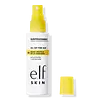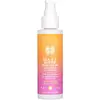What's inside
What's inside
 Key Ingredients
Key Ingredients

 Benefits
Benefits

 Concerns
Concerns

 Ingredients Side-by-side
Ingredients Side-by-side

Butyl Methoxydibenzoylmethane 2.9%
UV AbsorberEthylhexyl Salicylate 4.9%
UV AbsorberOctocrylene 9.5%
UV AbsorberAlcohol Denat.
AntimicrobialButyloctyl Salicylate
Skin ConditioningIsododecane
EmollientDiisooctyl Succinate
EmollientDiheptyl Succinate
EmollientSilica Caprylyl Silylate
Dicaprylyl Carbonate
EmollientHelianthus Annuus Seed Oil
EmollientCitrullus Lanatus Fruit Extract
Skin ConditioningOpuntia Ficus-Indica Seed Oil
EmollientBisabolol
MaskingPvp
Emulsion StabilisingCapryloyl Glycerin/Sebacic Acid Copolymer
Skin ConditioningEthyl Ferulate
AntioxidantTocopherol
AntioxidantBeta-Sitosterol
Emulsion StabilisingSqualene
EmollientNylon-12
Lauroyl Lysine
Skin ConditioningButyl Methoxydibenzoylmethane 2.9%, Ethylhexyl Salicylate 4.9%, Octocrylene 9.5%, Alcohol Denat., Butyloctyl Salicylate, Isododecane, Diisooctyl Succinate, Diheptyl Succinate, Silica Caprylyl Silylate, Dicaprylyl Carbonate, Helianthus Annuus Seed Oil, Citrullus Lanatus Fruit Extract, Opuntia Ficus-Indica Seed Oil, Bisabolol, Pvp, Capryloyl Glycerin/Sebacic Acid Copolymer, Ethyl Ferulate, Tocopherol, Beta-Sitosterol, Squalene, Nylon-12, Lauroyl Lysine
Octocrylene 2.9%
UV AbsorberWater
Skin ConditioningButyloctyl Salicylate
Skin ConditioningCoconut Alkanes
EmollientCalcium Sodium Borosilicate
Cetearyl Alcohol
EmollientParfum
MaskingPropanediol
SolventAscorbic Acid
AntioxidantTocopherol
AntioxidantAscophyllum Nodosum Extract
Skin ConditioningAlgae Extract
EmollientWithania Somnifera Root Extract
Skin ConditioningAloe Barbadensis Leaf Juice
Skin ConditioningCaffeine
Skin ConditioningCaprylhydroxamic Acid
Caprylyl Glycol
EmollientCellulose Gum
Emulsion StabilisingCoco-Caprylate/Caprate
EmollientCoco-Glucoside
CleansingEthyl Ferulate
AntioxidantFructose
HumectantGlycerin
HumectantGlyceryl Stearate
EmollientLauroyl Lysine
Skin ConditioningMicrocrystalline Cellulose
AbsorbentSodium Gluconate
Skin ConditioningSodium Stearoyl Glutamate
CleansingXanthan Gum
EmulsifyingOctocrylene 2.9%, Water, Butyloctyl Salicylate, Coconut Alkanes, Calcium Sodium Borosilicate, Cetearyl Alcohol, Parfum, Propanediol, Ascorbic Acid, Tocopherol, Ascophyllum Nodosum Extract, Algae Extract, Withania Somnifera Root Extract, Aloe Barbadensis Leaf Juice, Caffeine, Caprylhydroxamic Acid, Caprylyl Glycol, Cellulose Gum, Coco-Caprylate/Caprate, Coco-Glucoside, Ethyl Ferulate, Fructose, Glycerin, Glyceryl Stearate, Lauroyl Lysine, Microcrystalline Cellulose, Sodium Gluconate, Sodium Stearoyl Glutamate, Xanthan Gum
 Reviews
Reviews

Ingredients Explained
These ingredients are found in both products.
Ingredients higher up in an ingredient list are typically present in a larger amount.
Butyloctyl Salicylate is a chemical UV filter structurally similar to octisalate. It is a photostabilizer, SPF booster, emollient and solvent. This ingredient helps evenly spread out ingredients.
According to a manufacturer, it is suitable for pairing with micro Titanium Dioxide, Zinc Oxide, and pigments.
Photostabilizers help stabilize UV-filters and prevents them from degrading quickly.
Learn more about Butyloctyl SalicylateEthyl ferulate is an antioxidant derived from ferulic acid and ethyl alcohol. You'll most likely see this ingredient in sunscreens.
One study from 2014 found a concentration of 10% showed a similar SPF to Benzimidazole. Though this is considered a chemical UV filter, this ingredient is not listed as so. This is due to regulatory loopholes. You'll likely find this ingredient in "100% mineral" sunscreens.
This ingredient is typically found in concentrations between 0.5-1%. It is usually created synthetically or from rice bran oil.
Learn more about Ethyl FerulateThis ingredient comes from a fatty acid (lauric acid) and amino acid (lysine). It is used to add a silky feel to cosmetics.
According to a manufacturer, its fatty acid base leaves a silky feeling on the skin. It also has emollient properties because of this. Emollients help soften skin by preventing water from evaporating.
Lauroyl lysine is barely soluble in water.
Learn more about Lauroyl LysineOctocrylene protects skin from sun damage. It absorbs UV-B with peak absorption of 304 nm. It is a common sunscreen ingredient and often paired with avobenzone, a UVA filter. This is because octocrylene stabilizes other sunscreen ingredients by protecting them from degradation when exposed to sunlight. Octocrylene is a photostable ingredient and loses about 10% of SPF in 95 minutes.
Octocrylene also acts as an emollient, meaning it helps skin retain moisture and softens skin. It is oil-soluble and hydrophobic, enhancing water-resistant properties in a product.
Those who are using ketoprofen, a topical anti-inflammatory drug, may experience an allergic reaction when using octocrylene. It is best to speak with a healthcare professional about using sunscreens with octocrylene.
The EU allows a maximum of these concentrations:
Learn more about OctocryleneTocopherol (also known as Vitamin E) is a common antioxidant used to help protect the skin from free-radicals and strengthen the skin barrier. It's also fat soluble - this means our skin is great at absorbing it.
Vitamin E also helps keep your natural skin lipids healthy. Your lipid skin barrier naturally consists of lipids, ceramides, and fatty acids. Vitamin E offers extra protection for your skin’s lipid barrier, keeping your skin healthy and nourished.
Another benefit is a bit of UV protection. Vitamin E helps reduce the damage caused by UVB rays. (It should not replace your sunscreen). Combining it with Vitamin C can decrease sunburned cells and hyperpigmentation after UV exposure.
You might have noticed Vitamin E + C often paired together. This is because it is great at stabilizing Vitamin C. Using the two together helps increase the effectiveness of both ingredients.
There are often claims that Vitamin E can reduce/prevent scarring, but these claims haven't been confirmed by scientific research.
Learn more about Tocopherol